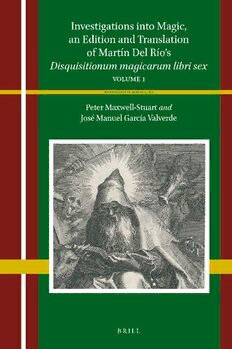Table Of ContentInvestigationsintoMagic,anEditionandTranslationofMartínDelRío’s
Disquisitionummagicarumlibrisex
Heterodoxia Iberica
GeneralEditor
JorgeLedo(UniversidadedaCoruña)
EditorialBoard
FernandoBouza(UniversidadComplutense)
NuriadeCastilla(EcolePratiquedesHautesEtudes,psl,Paris)
MercedesGarcía-Arenal(ConsejoSuperiordeInvestigacionesCientíficas)
IgnacioJ.GarcíaPinilla(UniversidaddeCastilla–LaMancha)
CarlosGilly(BibliothecaPhilosophicaHermetica –UniversitätBasel)
LuisGirónNegrón(HarvardUniversity)
JonathanIsrael(InstituteforAdvancedStudy –PrincetonUniversity)
XavierTubau(ConsejoSuperiordeInvestigacionesCientíficas)
MaríaJoséVega(UniversitatAutònomadeBarcelona)
JoséLuisVillacañas(UniversidadComplutense,Madrid)
volume 6.1
Thetitlespublishedinthisseriesarelistedatbrill.com/hdib
Investigations into Magic, an
Edition and Translation of Martín
Del Río’s Disquisitionum
magicarum libri sex
Volume1
By
PeterMaxwell-Stuart
JoséManuelGarcíaValverde
leiden | boston
Coverillustration:HeiligeAntoniusdeGrotevanEgypte(AntoniusAbt)alskluizenaarmetdeduivelin
verschillendegedaantendieheminverzoekingbrengen,designedbyAbrahamBloemaertandprintedby
BoëtiusAdamszBloswertbetween1590–1612.Rijksmuseumobjectnumber:RP-P-BI-2342.PublicDomain.
TheLibraryofCongressCataloging-in-PublicationDataisavailableonlineathttp://catalog.loc.gov
lcrecordavailableathttp://lccn.loc.gov/2022021610
TypefacefortheLatin,Greek,andCyrillicscripts:“Brill”.Seeanddownload:brill.com/brill‑typeface.
issn2213-0594
isbn978-90-04-44154-5(hardback)
isbn978-90-04-44153-8(e-book)
Copyright2022byP.G.Maxwell-StuartandJ.M.G.Valverde.PublishedbyKoninklijkeBrillnv,Leiden,
TheNetherlands.
KoninklijkeBrillnvincorporatestheimprintsBrill,BrillNijhoff,BrillHotei,BrillSchöningh,BrillFink,
Brillmentis,Vandenhoeck&Ruprecht,BöhlauandV&Runipress.
KoninklijkeBrillnvreservestherighttoprotectthispublicationagainstunauthorizeduse.Requestsfor
re-useand/ortranslationsmustbeaddressedtoKoninklijkeBrillnvviabrill.comorcopyright.com.
Thisbookisprintedonacid-freepaperandproducedinasustainablemanner.
Contents
Introduction 1
NoteontheLatinText 51
Disquisitionummagicarumlibrisex
Defence,orApologia 54
LettertoPrinceErnst 70
Poems 76
Approvals 100
Prologue 108
Book1:OnMagicinGeneral,andonNaturalandArtificialMagicin
Particular 130
1 SuperstitionandIts[various]types 130
2 Magic,ItsTypes,andtheDifferentWordsfor‘Magician’ 136
3 NaturalMagic,ortheMagicWhichRelatestotheCreated
Universe 148
3.1 WhatBearingDoHeavenlyAspectsandInfluxesHaveonthe
PerformanceofMagic? 164
3.2 CanMagicalPerformancesofThisKind,WhichResembleMiracles,
AriseFromaHumanBeing’sNaturalTemperament? 178
3.3 HowGreatisthePoweroftheImagination,andWhatSortofThing
IsIt,inRespectofTheseWonderfulEffects? 180
3.4 CanWoundsandDiseasesBeCuredSimplybyTouch,Sight,Voice,
Breath,Kiss,orMerelybyBindingwithaLinenCloth,andCanOther
ExtraordinaryThingsofThisKindBeAccomplished
Naturally? 204
4 InstrumentalMagic 246
4.1 DoCharacters,Rings,Sigils,orImagesHavethekindofPower
MagiciansClaim? 260
4.2 IsThereAnyMagicalPowerintheNumbersUsedinArithmeticor
Music? 270
4.3 DoWordsorIncantationsHavetheInnatePowertoCuretheSickor
AccomplishWonders? 308
4.4 AmuletsandPeriapts 326
vi contents
5 ToWhichTypeofMagicShouldOneAssigntheTechniqueofMaking
Gold,Knownas‘Alchemy’? 340
5.1 IsRealGoldMadebymeansofThisTechnique? 340
5.1.1 WhatIsAlchemy,andWhenWasItDiscovered? 342
5.1.2 TheEffectivenessoftheTechniqueofAlchemyinMaking
Gold 352
5.1.3 MoreAboutThatSameEffectiveness 380
5.1.4 IsThereAnyLiteratureWhichHasEstablishedThatGold
HasBeenMadebyMeansofThisTechnique? 386
5.2 ShouldGold-MakingBeConsideredOneoftheNobleArtsorClassed
asWorkforArtisans? 394
5.3 ToWhatTypeofMagicDoes[Alchemy]Belong? 396
5.4 IsAlchemyLawfulorUnlawful? 406
Bibliography 431
IndextoBook1 442
Introduction
1 DelRío’sLifeandLiteraryCorpus
Callimachusissaidtohaveobserved,μέγαβιβλίον,μέγακακόν,‘abigbookis
a big evil,’ and since Del Río’s work is large enough in itself, perhaps a long
introductionwouldservemerelytotestthereader’spatiencetobreakingpoint
whereasheorshewillneedeveryounceofittocopewiththeimmensedetail
withwhichDelRíoembellishedwhatheclearlyintendedtobetheultimate
word on the subject. These preliminary words will therefore be kept as few
aspossibleinordertoletDelRíospeakforhimself.Isheworththereader’s
effort? Yes, he is. To be sure, he is not an easy companion and, indeed, can
sometimesbeexasperating,buthissheerdiligenceinanagewithouttheready
aids of modern scholarship, not to mention his battles with increasing bad
healthandnear-blindnessandthediscomfortsanddangers(toexpressthem
no more vividly than that) of sixteenth-century travel by land and sea in a
Europerivenbywarandlocallawlessness,elicitone’sadmirationandthis,in
turn,increasesone’scuriositytofindoutwhathehastosay.Forallitslength,
hisbookisnomeredryorramblingcompilationofquotations;norisitsimply
are-hashof whatothershadsaidadozentimesbefore.Itisindeedpartlyan
exhaustivesurveyofmaterialrelatingtomagicandalliedbeliefs,practices,and
theories, but it is also a record of one man’s quirky, but carefully-considered
meditationuponaninteractionbetweenthephysicalandnon-physicalworlds
which seemed to be growing rapidly out of control and posing a an existen-
tialmenacetohumanity.ItisperhapsnoaccidentthatDelRíowasaJesuit,
a member of God’s shock-troops whose task was to fight the forces, human
or not, which threatened to subvert God’s plan for the well-being and salva-
tionofHiscreation.Awarisnotwonbytacticsalone.Strategyisessentialand
strategydependsonasfullanunderstandingaspossibleoftheenemyinallhis
strengths,weaknesses,andlikelyintentions.HenceDelRío’sthoroughness.He
sawhimself notonlyasaspokesmanfortheCatholicChurch,butalsoasher
doughtydefenderandprincipalstrategist,sincehisworkwaslayingthefound-
ationsof herfutureinvincibilityinherstrugglewiththeforcesof evilinthe
secularworld.Hisintentions(andindeedachievement)inthe Disquisitiones
thus go well beyond those of any other contemporary writer on the subject-
matter,whoseaimswereingeneralmorelimitedandlessgrandiose,andhis
voice,whichnotonlyinformsthewholework,butbreaksthroughhistextover
andoveragain,isnotmerelycombative,butassuredanddistinctiveinaway
whichcommandsthereader’scloseattention.
© P.G.Maxwell-StuartandJ.M.G.Valverde,2022 | doi:10.1163/9789004441538_002
2 introduction
MartínAntoniodelRíowasbornon17thMay1551inAntwerpwhichwas
then a bustling trading-centrein the Duchyof Brabantin the Spanish Neth-
erlands. Nomenclature can be misleading. During the sixteenth century, for
example,‘theNetherlands’includedterritoriesremarkablydifferentincharac-
ter,language,andgovernment,nottomentionreligionlateron,owingpolit-
ical allegiance to rulers as disparate as the Spanish Habsburgs, the Church,
theSpanishCrown,andindependentDutchauthorities.‘Belgium,’too,aterm
whichappearsquitefrequentlyinDelRío’swork,ineffectreferredtotheSpan-
ish Netherlands during his life-time, that is, territories governed de facto by
PhilipiiofSpainasaresult,firstofCharlesv’sdeclarationin1549thatthesev-
enteenprovincesofwhichtheywereconstitutedwasaHabsburgfiefdomand
then,from1556onwards,afterCharlesv’sabdicationasHolyRomanEmperor
andthesuccessionof PhilipiitotheSpanishthrone.1Itwasnotlongbefore
this led to a revolt and in 1568, in part at least because of a growth of rad-
icalformsofProtestantism,especiallyCalvinism,whichmadethemselvesfelt
throughouttheNetherlands,andthestrongcounter-measuresadoptedbythe
Spanishauthorities,theopeningsalvoeswerefiredinaconflictwhichwould
laterbetermed‘theEightyYearsWar.’AsignificantpartofDelRío’slife,there-
fore,sawhisnativecountry(althoughhemaynothavevieweditinquitethose
terms)rivenbypoliticalinstabilityandreligioustension.Indeed,thisinstabil-
ity and tension affected him and his family personally, and it was not until
hejoinedtheSocietyof Jesusin1580—notintheNetherlands,butinSpain,
the land of his parents’ birth—that politics moved from the forefront of his
mind to the back and were replaced, perhaps not entirely, but certainly for
the most part, by religion and the battle, as he saw it, for higher truth. His
father,AntonioDelRío,wasaSpanishmerchant,originallyfromCastile,and
his mother, Eleonora López deVillanova, also came from merchant stock in
Aragon.2Antwerphaddevelopedintoamajorportconcentratingonthecom-
merceof fairlyexpensiveitemsandattractedalargenumberof Spanishand
Portuguese traders. Friso Wielenga succinctly expresses its situation at this
time:
1 TheyconsistedoftheDuchiesofBrabant,Limberg,Luxembourg,andpartofGuelders,the
CountiesofArtois,Flanders,Namur,andHainaut,theLordshipofMechelen,cityofTournai,
andthesurroundingarea,andthePrince-BishopricofCambrai.
2 AmarginalnotetoacopyofRosweyde’sLife,heldinthePlantin-MoretusMuseum,saysthat
‘amongserious-mindedmeninSpain,therewasdisagreementaboutwhetherthenamesDelrio
andDelrío[Delrius]wereoneandthesameordifferent,adoubtwhichcausedthechangeof
names,’i.e.fromDelRiotoDelRío.IamgratefultoJanMachielsenforprovidingmewitha
copyofthesemarginalia.
introduction 3
Athrivingeconomicandmilitarystrategicnorthernhubwasbuildingup
roundAntwerp,andthiswasofkeysignificancetotheconsolidationand
expansionofthepositionoftheHabsburgsinEuropeandtherestofthe
world.3
AsamemberoftheSpanishinfluxwhichwascomingtodominatethehigher
echelonsofAntwerpsociety,Martín,therefore,alongwithhisyoungerbrother,
Jerónimo, grew up in comfortable surroundings and in what would now be
called an upwardly-mobile family which had high expectations of itself and
itsimmediatefutureandatonepointtheirfather,accordingtoHeribertRos-
weyde,wasabletobuildanew,almostpalatialfamilyhomeinoneofthemost
fashionableandexpensivepartsof thecity,wheretheDelRíosreceivedand
entertainedMargaretofParmaandtheDukeofAlba,twogovernors-generalof
theSpanishNetherlands,whentheystayedinAntwerp.
RosweydetellsusthatMartínreceivedatleastpartof hisearlyeducation
in Lier which is about eighteen miles south-east of Antwerp.Why did he go
thereratherthanstayinAntwerp?Theanswermaylieintheincreasedstatus
andfreshpropertyacquiredbyhisfatherAntonio.In1557heboughtthecastle
andlordshipofCleydaelwhichisnearlysevenmilesduesouthofAntwerpand
then, in 1561, when Martín was just over ten years old, Antonio bought him
the seigniorial rights of Aartselaar which is just over seven miles due south
of Antwerpandonlyaboutoneandahalf milessouth-eastof Cleydael.Lier,
however,isnearlyeighteenandahalfmilesfromAntwerp,nearlythirteenfrom
Cleydael, and nearly thirteen again from Aartselaar.These distances suggest
it would have been too far for Martín, still a child at this time, to have trav-
elled from either Antwerp or Cleydael or Aartselaar to Lier on a daily basis,
andthatthereforethatitismorelikelyheeitherreceivedthemajorityof his
education, at any rate, in Antwerp, or was sent away, as Erasmus was at the
ageof nine,tobenefitfromaschoolparticularlyknownforitsClassicaledu-
cation.4 It included a good grounding in Latin and Greek, to which he later
addedHebrewandaworkingknowledgeof Chaldee[Aramaic].Hewillalso
3 AHistoryoftheNetherlands,11.
4 ErasmuswassenttoDeventer,whichisc.89milesawayfromhisbirthplaceofRotterdam.
TheschooltherehadagreatreputationforitsLatinteaching.Lierhadbeensufficientlynote-
worthyin1425tohavebeenofferedthechanceofhostingtheregion’sfirstuniversity,achance
itturneddown,whereuponitwasseizedbyLeuvenwhichwasthengranteditsfoundationin
aPapalBullofPopeMartinv.SinceeducationdoesnotseemtohavebeenoneofLier’spri-
oritiesatthetime,itisthereforesomewhatdifficult(quiteapartfromthepracticaltravelling
difficulties)toseewhyDelRíowouldhavegonethereatall,letalonespentanyprotracted
periodthereunlessithadhadasimilarlyrenownedschool.

